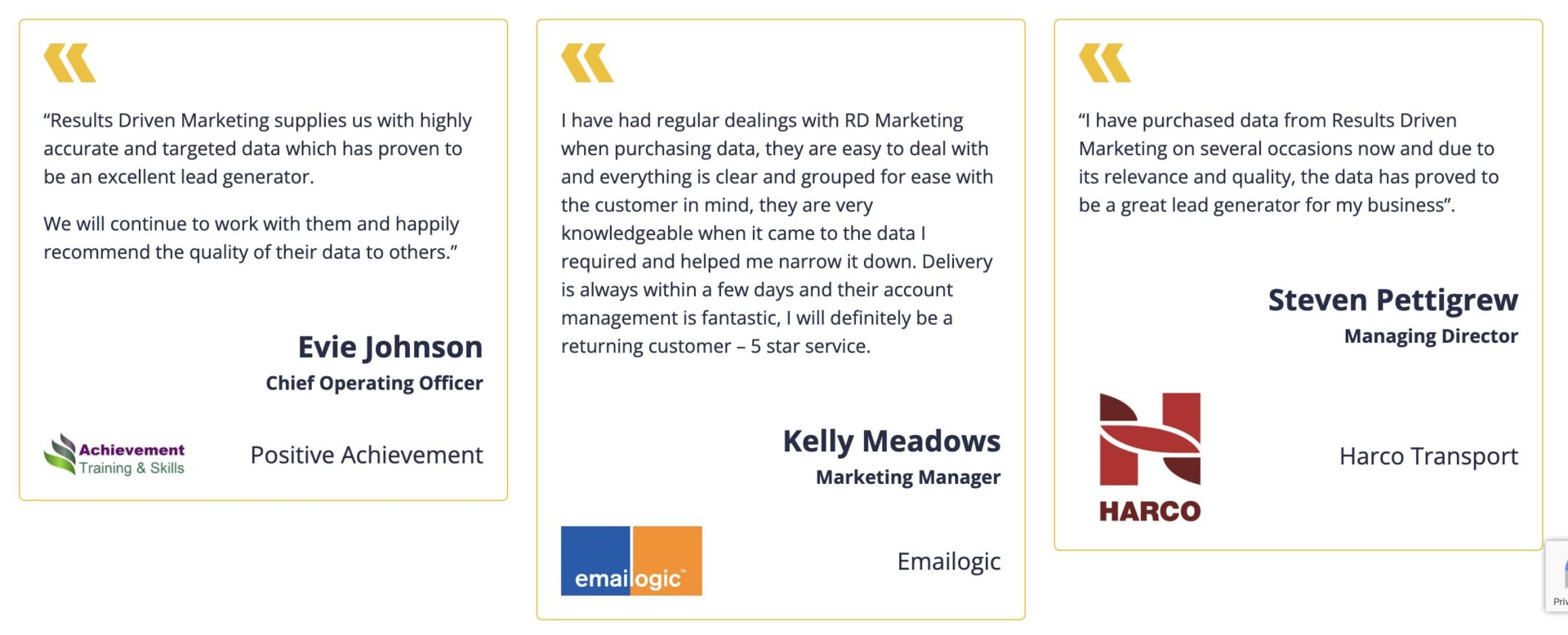
Data Lists to Connect with Decision-Makers
Data lists are the backbone of effective marketing campaigns, providing businesses with the precise information they need to reach the right audience. Whether you’re launching an email campaign, planning direct mail outreach, or building a telemarketing strategy, using accurate and targeted data lists can transform your efforts and drive meaningful results.
In this article, we’ll explore everything you need to know about data lists—what they are, how they work, and why they’re essential for modern businesses. You’ll discover how to choose and maintain high-quality data lists that align with your marketing goals, and we’ll share tips for maximising their impact.
At Results Driven Marketing, we specialise in providing reliable, GDPR-compliant data lists tailored to your needs. Whether you’re targeting UK SMEs or expanding globally, our data lists are designed to help you connect with decision-makers, increase engagement, and boost ROI.
Table of contents:
What Are Data Lists?
Data lists are powerful marketing tools that help businesses connect directly with their target audience. Specifically designed for companies looking to promote their products and services, these lists focus on delivering contact information for decision-makers within UK SMEs. Think of them as a shortcut to reaching the right people, saving time and resources while maximising the impact of your campaigns.
But data lists are more than just collections of names and email addresses—they’re carefully curated databases that allow businesses to target their ideal audience with precision. By providing valuable insights like job roles, industries, and company locations, data lists enable businesses to craft personalised, relevant messaging that resonates with potential clients.
Understanding and using data lists is essential for any business aiming to grow. They allow you to:
- Reach the Right Audience: Focus your efforts on decision-makers who are likely to be interested in your offerings.
- Save Time and Resources: Skip the guesswork and connect with qualified leads directly.
- Drive Measurable Results: Increase engagement, boost conversions, and achieve higher ROI.
For any business aiming to scale or optimise its marketing efforts, data lists are an invaluable asset to success.
Why Using Data Lists Represents Such a Big Opportunity
Reaching the right audience at the right time is crucial for success. That’s why using data lists is such a game-changer for businesses. These curated marketing lists allow you to connect directly with decision-makers, streamline your campaigns, and achieve your goals faster.
Here’s why data lists represent a significant opportunity:
- Targeted Precision: With data lists, you’re not casting a wide net and hoping for results. Instead, you’re reaching specific UK SMEs and senior decision-makers who are most likely to benefit from your products or services.
- Personalised Campaigns: The information provided in data lists, such as job titles, industries, and company details, lets you craft highly personalised messages. Personalisation drives higher engagement and boosts conversions.
- Cost-Effective Marketing: By focusing on qualified leads, data lists help you avoid wasted time and resources. You’ll invest in campaigns that deliver real results, ensuring better ROI.
- Scalable Growth: Whether you’re targeting a niche market or expanding your reach, data lists scale with your business. They provide the flexibility to align with your growth strategies.
- Faster Results: Direct access to decision-makers allows for quicker responses, whether you’re generating leads, booking meetings, or closing deals.
Using data lists is more than just smart marketing—it’s a way to stay ahead of the competition. By leveraging accurate, up-to-date data, businesses can create impactful campaigns that connect, engage, and convert. It’s an opportunity no business should miss!
Who Uses Data Lists?
Data lists are invaluable tools for businesses across a wide range of sectors, helping them connect directly with senior purchasing decision-makers. Whether you’re a small business or a large enterprise, data lists provide a targeted, efficient way to promote products and services. Here’s a look at who benefits most from using them:
- B2B Marketers: Marketing professionals use data lists to create highly targeted campaigns that reach decision-makers in their ideal sectors. This ensures their messaging is relevant, personalized, and more likely to convert.
- Sales Teams: For sales professionals, data lists are a shortcut to finding and contacting qualified leads. They help sales teams focus on prospects with real purchasing power, saving time and boosting productivity.
- Event Organisers: Webinars, trade shows, and networking events thrive on attendance from the right audience. Event planners use data lists to invite key players and ensure maximum engagement.
- Service Providers: IT services, financial consultants, and other B2B providers use data lists to showcase their expertise directly to those who need their services, driving leads and building long-term relationships.
- Startups and SMEs: New and growing businesses leverage data lists to quickly establish connections with decision-makers, helping them gain a foothold in competitive markets.
- Manufacturers and Suppliers: From construction to retail, companies use data lists to connect with buyers, distributors, or key decision-makers in specific sectors, ensuring efficient and impactful outreach.
No matter your industry, using data lists gives you a clear edge by ensuring your message reaches the people who matter most—those with the authority to make decisions. It’s a tool that’s essential for success in today’s business landscape
Why Buy Data Lists from Results Driven Marketing?
When it comes to connecting with senior purchasing decision-makers within UK SMEs, Results Driven Marketing is your trusted partner. Our data lists are carefully crafted to ensure your message reaches the right people, driving real results for your campaigns. But why choose us? Here’s what sets us apart:
- Highly Targeted Data: Our data lists are tailored to your specific needs, focusing on key decision-makers within UK SMEs. This ensures your campaigns are relevant, targeted, and designed to convert.
- Up-to-Date and Accurate: We pride ourselves on delivering data lists that are meticulously maintained and refreshed regularly. With our lists, you’ll avoid wasting time and resources on outdated or irrelevant contacts.
- GDPR-Compliant Data: Compliance is at the heart of what we do. Our data lists adhere to GDPR regulations, giving you peace of mind and protecting your reputation.
- Proven ROI: Clients who use our data lists see significant improvements in engagement, lead quality, and conversion rates. Our data doesn’t just connect you to prospects—it connects you to results.
- Expert Guidance: With over seven years of experience, we don’t just provide data; we provide expertise. Our team is here to help you maximise the potential of your campaigns.
At Results Driven Marketing, we’re committed to helping your business succeed. Our data lists are more than just contact information—they’re your pathway to smarter, more effective marketing. Ready to take your campaigns to the next level?
What Our Clients Say About Our Data Lists
At Results Driven Marketing, we’re proud to be the trusted provider of data lists for businesses across the UK. From improving lead quality to maximizing ROI, our clients rely on us for accurate, GDPR-compliant data that drives real results.
Here’s what some of our clients have to say:
Want to learn more about how our data lists can boost your results? Check out our Testimonials Page for more client success stories.
Curious about the potential impact on your ROI? Use our ROI Calculator to see how our data lists can make a measurable difference for your business! Let’s achieve your marketing goals together.
How Other Businesses Are Leveraging Data Lists to Their Benefit
Businesses across industries are achieving incredible results by strategically using data lists to power their marketing campaigns. These curated lists allow companies to connect directly with senior decision-makers, making their outreach more targeted, efficient, and impactful.
Here are some of the ways businesses are leveraging data lists to their benefit:
- Generating High-Quality Leads: Companies use data lists to focus on prospects that matter. By targeting decision-makers in specific industries or sectors, businesses save time and resources while ensuring their campaigns reach those most likely to convert.
- Driving Event Attendance: From webinars to trade shows, businesses use data lists to invite the right audience, ensuring events are filled with engaged participants who are genuinely interested in their offerings.
- Launching New Products and Services: Data lists are perfect for generating buzz. Businesses introduce new offerings directly to decision-makers, creating opportunities for early adopters and influencers to get on board.
- Building Stronger Relationships: Beyond initial contact, data lists allow businesses to nurture long-term relationships. By segmenting lists and tailoring messaging, they deliver value consistently, building trust and loyalty.
- Boosting ROI: Data-driven campaigns tend to perform better. With precise targeting, businesses achieve higher open rates, engagement, and conversions, making every marketing dollar count.
By leveraging data lists, businesses are unlocking new opportunities to connect with their target audience, foster meaningful relationships, and achieve measurable growth. It’s a proven strategy that helps them stay ahead in competitive markets.
Ready to see how data lists can benefit your business? Let Results Driven Marketing help you take the first step toward smarter, more effective marketing.
FAQs About Data Lists
If you’re exploring how data lists can enhance your marketing efforts, you probably have questions. Below, we’ve compiled answers to the most common queries about data lists to help you make informed decisions and get the most out of this powerful tool.
What types of information are included in data lists?
Data lists typically include:
- Names and job titles of contacts
- Email addresses
- Phone numbers (if applicable)
- Company names and industries
- Business locations
- Company size or revenue (in some cases)
This detailed information allows for precise targeting and tailored messaging.
How do data lists benefit businesses?
Using data lists helps businesses:
- Save Time: Skip the guesswork and focus directly on decision-makers.
- Increase Campaign Effectiveness: Reach an audience that’s most likely to engage with your offering.
- Boost ROI: Targeted campaigns typically lead to better engagement and conversions.
- Personalise Outreach: Use segmentation to deliver messages that resonate with specific groups.
For businesses looking to maximise their marketing efforts, data lists provide a clear competitive edge.
Are data lists GDPR-compliant?
Yes, reputable providers like Results Driven Marketing ensure their data lists are GDPR-compliant. This means all contact information is obtained legally, with the necessary permissions, and regularly updated to comply with data protection laws.
Using compliant data lists protects your business from legal risks while maintaining trust with your audience.
How do I know if a data list is right for my business?
A data list is right for your business if:
- You know your target audience (e.g., industries, job roles, or company sizes).
- You’re looking to generate high-quality leads.
- You want to run personalised and targeted marketing campaigns.
- You aim to save time and resources by focusing on decision-makers.
If you’re unsure, we can help you identify the right list for your goals.
Can I use my data lists with email marketing platforms?
Absolutely! Platforms like our Responder are designed to accept all email lists. This allows you to seamlessly upload your data and start running campaigns without delays.
How often should I update my data lists?
Regular updates are essential to maintain the effectiveness of your data lists. Ideally, your lists should be updated:
- Quarterly: To remove outdated contacts and add new leads.
- Before Major Campaigns: To ensure all information is current and relevant.
Results Driven Marketing keeps its data lists refreshed and up-to-date, so you don’t have to worry about accuracy.
What’s the difference between a purchased data list and building my own?
- Purchased Data Lists: Ready-to-use and targeted, saving you time and effort. They come with detailed insights about your audience.
- Building Your Own: Requires significant time and resources to gather contact information and verify accuracy.
Purchased data lists from trusted providers like us ensure accuracy, compliance, and a faster route to reaching decision-makers.
How do I measure the success of a campaign using data lists?
To track the effectiveness of your campaigns, monitor these key metrics:
- Open Rate: The percentage of recipients who opened your email.
- Click-Through Rate (CTR): The percentage of recipients who clicked on links within your email.
- Conversion Rate: The percentage of recipients who completed the desired action, such as filling out a form or making a purchase.
- Bounce Rate: The percentage of emails that weren’t delivered.
- Unsubscribe Rate: The percentage of recipients who opted out of future emails.
Analysing these metrics helps you optimise future campaigns for better results.
Why choose Results Driven Marketing for data lists?
At Results Driven Marketing, we’ve been providing accurate, GDPR-compliant data lists to businesses in the UK, Europe, and globally for over 7 years. Here’s why businesses trust us:
- Targeted Lists: Tailored to your industry, audience, and goals.
- Up-to-Date Data: Regularly refreshed to ensure accuracy.
- Compliance: All data is GDPR-compliant.
- Expertise: Our team offers guidance to help you maximise the impact of your campaigns.
Learn more about our services on our Testimonials Page or calculate the ROI of using our data lists with our ROI Calculator.
How can I get started with data lists?
Getting started is simple. Contact us to discuss your requirements, and we’ll help you find the perfect data list for your marketing needs. Whether you’re running your campaigns with our Responder platform or opting for our managed email services, we’ll ensure your marketing efforts are set up for success.
Using data lists is a proven way to drive engagement, generate leads, and grow your business. Let us help you unlock their full potential!
Who We Are
At Results Driven Marketing, we are proud to be a highly experienced marketing list supplier, helping businesses in the UK, Europe, and globally achieve their marketing goals for over 7 years. Our mission is to provide businesses with the tools they need to connect with the right audience and drive meaningful results.
We specialise in supplying the most accurate and up-to-date files, ensuring your campaigns are powered by reliable and GDPR-compliant data. Whether you’re targeting senior decision-makers in UK SMEs or expanding your reach internationally, our marketing lists are designed to deliver maximum impact.
But we don’t just stop at providing data. With years of email marketing expertise, we offer tailored guidance and support to help you create effective campaigns that truly resonate with your audience.
Ready to take your marketing to the next level? Explore our services and buy email addresses today to start connecting with your ideal customers. Let’s work together to make your campaigns smarter, sharper, and more successful!
What are the main benefits of using data lists?
Access to Highly Targeted Contact Information
Business mailing lists can help businesses segment target audiences quickly and accurately. This helps ensure that the right people and companies get the right messages.
Low Cost Marketing
Bulk mailing lists are one of the most cost effective marketing tools available to businesses. By having access to an accurate and up-to-date list of contacts, companies can save time, money, and resources.
Increased Brand Recognition
Sending direct mailers to targeted audiences can help build brand recognition. Brand messaging can be easier to understand through direct mail and help create recognition among potential customers.
Increased Connections with Potential Customers
Business mailing lists can help companies make connections with potential clients. By connecting with the right people, businesses can create meaningful relationships with their target audiences.
Opportunity to Increase Sales
With the right mailing list, businesses can increase sales opportunities. By targeting the right people, businesses can identify potential customers and create a tailored marketing message to reach them.
Improved Quality of Leads
Quality leads create better sales. By utilising mailing lists, businesses can access information to segment the right contacts and create highly targeted campaigns. This will help ensure that the leads generated are of high quality.
What are the different types of data lists?
Industry Specific Business Lists
These lists include detailed information on businesses within a specific industry, including information on location, size and contact details.
Targeted Business Lists
These lists focus on specific criteria, such as geography, demographics, and size, so that you can focus on the customers that you’re interested in marketing to.
Executive Lists
These are high-end business lists focused on C-level executives and senior decision makers within an organisation.
Compiled Business Lists
These are lists compiled from publicly available sources that offer basic contact information, such as name and email address.
Specialty Business Lists
These lists are tailored to include businesses that fit within the parameters of the particular industry you’re interested in.
How to build data lists?
Use opt-in forms on your website or landing pages
Include an opt-in box on company invoices or receipts
Collect email addresses at trade shows, conferences, or other events
Leverage social media
Utilise any partnerships or connections you have
Offer incentives for signing up
Buying a third-party list
There is so much to cover that I won’t go into full detail now, but I will cover the absolute basics.
Make sure you have a clear data brief
It is essential to understand exactly who your target audience is and to develop an ICP.
You can do this on your own but may want to consider working alongside a supplier like Results Driven Marketing at this point to help you ask the questions of your customer database that you need to.
These questions might be along the lines of:
Where are your top customers located geographically? What sectors do they operate in? How many staff do they have? How much do they turnover? Who within those organisations do you look to target?
Make sure your potential supplier provides you with samples and breakdowns
Getting this information is really important to make sure that your supplier fully understands your brief and is aware of exactly what your ICP is. At Results Driven Marketing, we supply both breakdowns and then samples. This makes sure clients are comfortable that we clearly understand and will be delivering a database that will work for you.
Check the licensing terms
Post-GDPR, most suppliers offer licensed products. The most common is a 12-month multi-use licence. This might sound like you can use it as much as you like over a 12-month period but may actually be limited to 12 email sends only. We find that 12 emails sends over a 12-month period are adequate, but it is important that you understand all the usage rules before you dive in.
Check supplier accuracy guarantees
Is the supplier’s database guaranteed accurate? What if you get it and all the emails bounce? Ask your supplier what guarantees they have in place should things not work out as you would expect.
All files released by us are guaranteed accurate to industry high standards and are GDPR compliant.
We guarantee:
- 98% postal address accuracy
- 90% telephone number and contact name accuracy
- 90% email address accuracy
Should we fall below and of the above benchmarks, we are obliged to provide like-for-like replacements or a pro-rata refund.
Visit us here for more information.
How to segment data lists?
Collect and analyse customer data
Create customer segments
Identify your target audience
Create targeted campaigns
How to maintain data lists?
Keep it Up-to-Date
Make sure your business mailing list is always up-to-date. Regularly review and delete outdated email addresses, add new contacts, and update missing or incorrect customer information.
Reach Out Regularly
Make sure to reach out to your contacts regularly with professional messages and offers. If you’re not contacting your list regularly, you’re likely not getting the return you’d expect.
Segment Contacts
Segment your contacts into different lists so you can better target your messages. You can also create custom audiences based on customer behaviours, interests, or demographics.
Utilise Automation
Use automated processes and triggered emails to simplify the process of engaging contacts. You can use automation to save time and ensure that no customer goes unnoticed.
Analyse Your Data
Use analytics to get valuable insights from your business mailing list. Analyse your contact data to measure the success of your campaigns, uncover trends and opportunities, and understand your customers better.
How to cleanse your list?
Marketing to Data Lists
Email Marketing to Data Lists
What are the benefits of email marketing to data lists
In today’s fast-paced digital landscape, email marketing remains one of the most effective and reliable channels for businesses to engage with their target audience.
When it comes to B2B marketing, leveraging well-segmented and up-to-date data lists is crucial for success.
In this part of the article, we explore the undeniable benefits of email marketing when combined with B2B data lists, and how this powerful combination can drive growth, foster relationships, and maximise ROI.
1. Targeted and Personalised Communication
Email marketing allows businesses to tailor their messages to specific segments within their B2B data lists.
By leveraging the rich data available in these lists, marketers can personalise emails based on industry, job title, company size, or any other relevant criteria.
This level of customisation allows for more targeted communication, ensuring that recipients receive content that is both relevant and valuable to their specific needs.
The more personalised the email, the higher the chances of engagement and conversion.
2. Increased Reach and Brand Visibility
B2B data lists provide a treasure trove of contact information, enabling businesses to reach a broader audience of potential customers.
With email marketing, companies can directly reach decision-makers, influencers, and key stakeholders within target industries.
By consistently delivering high-quality content and nurturing relationships through email campaigns, businesses can enhance their brand visibility and establish themselves as industry thought leaders.
3. Cost-Effective Marketing Channel
Compared to traditional marketing channels, email marketing offers an exceptional return on investment (ROI).
Creating and sending emails is significantly more cost-effective than printing brochures, advertising in print media, or attending trade shows.
With B2B data lists, companies can segment their email campaigns based on specific criteria, ensuring that their messages are received by the most relevant prospects.
This targeted approach minimises wasted resources and maximises the impact of marketing efforts.
4. Measurable and Trackable Results
One of the major advantages of email marketing is the ability to track and measure campaign performance.
With modern email marketing software, businesses can monitor key metrics such as open rates, click-through rates, conversion rates, and more.
These insights provide valuable data that can be used to optimise future campaigns and improve overall marketing strategies.
By analysing the data from B2B data lists, businesses can gain a deeper understanding of their target audience and refine their messaging to increase engagement and conversions.
5. Automation and Scalability
Email marketing automation simplifies the process of reaching out to a large number of contacts in a timely and efficient manner.
By setting up automated email sequences triggered by specific actions or events, businesses can nurture leads, onboard new customers, and deliver personalised content at scale.
With B2B data lists, companies can create highly targeted automation workflows that ensure prospects receive the right messages at the right time, increasing the likelihood of conversion and fostering long-term customer relationships.
Conclusion
Email marketing combined with B2B data lists offers businesses a powerful tool to engage with their target audience, drive growth, and increase brand visibility.
The ability to deliver personalised content, reach decision-makers, and track campaign performance makes email marketing a cost-effective and efficient marketing channel.
By leveraging the benefits of email marketing, companies can unlock the full potential of their B2B data lists and achieve remarkable results in their marketing efforts.
Best practices for email marketing to data lists
Make sure your email copy is succinct, relevant and engaging
Utilise personalisation
You can use customer or demographic data to tailor emails to relevant subscribers.
Leverage segmentation
You should segment your database into different categories and target each group with emails that are tailored to their interests.
Include a call to action
Let subscribers know what you want them to do in order to take the next step.
Utilise A/B testing
Experiment with different variables in your emails to maximise their performance.
Monitor your metrics
Track various metrics from your emails (such as open rate, click-through rate, and conversion rate) to make sure your messages are effective.
How to A/B split test email marketing campaigns to data lists
Email marketing campaigns have become an indispensable tool for businesses looking to engage with their audience, drive conversions, and optimise their marketing strategies.
A/B split testing is a proven method that enables marketers to make data-driven decisions and improve the effectiveness of their email campaigns.
In this part of the article, we will delve into the process of conducting A/B split tests for email marketing campaigns to data lists, providing practical insights on how to optimise your email marketing efforts.
1. Define Your Testing Goals and Variables
Before diving into A/B split testing, it is crucial to identify clear goals for your email marketing campaign. What specific metrics or outcomes do you aim to improve? Examples could include open rates, click-through rates, conversion rates, or engagement with specific elements in your emails. Once you have defined your testing goals, determine the variables you want to test. These variables can range from subject lines and sender names to email layouts, calls to action, or even the timing of your emails.
2. Segment Your Data Lists
To conduct effective A/B split tests, it is essential to segment your data lists. By dividing your contacts into distinct groups, you can send different versions of your email to each segment and compare the results. It is important to ensure that your segments are representative and have a sufficient sample size to generate statistically significant results. Consider segmenting your data lists based on demographic factors, customer behaviour, or any other relevant criteria that align with your testing goals.
3. Determine Test Parameters and Variables
To conduct a successful A/B split test, you need to establish clear parameters for your tests. This includes defining the size of your test groups, deciding how long the test will run, and determining the statistical significance threshold you aim to achieve. Additionally, identify the specific variables you want to test within your emails. For example, you might want to compare different subject lines or test the impact of different CTAs. Make sure to change only one variable at a time to accurately attribute the impact to that specific element.
4. Develop Compelling Content Variations
Crafting distinct variations of your email content is crucial for an effective A/B split test. Whether you are testing subject lines, email body content, or design elements, ensure that each version is compelling and aligns with your overall messaging strategy. Keep the core message consistent across variations to minimise confounding factors. Test variations can include different copywriting styles, visual elements, length of content, or placement of key information. Always keep the preferences and needs of your target audience in mind when developing these variations.
5. Monitor and Analyse Performance
Launch your A/B split test by sending each variation to its respective test segment. As the test runs, closely monitor and measure the performance of each version based on your predefined metrics. Key metrics to track include open rates, click-through rates, conversion rates, and engagement with specific elements. Use email marketing software or analytics tools to gather accurate data and generate insightful reports. Remember to give your test enough time to gather sufficient data for meaningful analysis.
6. Draw Conclusions and Implement Learnings
Once your A/B split test has concluded, analyse the results and draw meaningful conclusions. Identify the winning variation based on the predefined metrics and statistically significant results. This variation becomes the benchmark for future campaigns. Take note of the insights gained from the test and implement the learnings into your email marketing strategy. Continually iterate and optimise your campaigns based on the results of A/B split tests to improve your overall email marketing performance.
7. Iterate and Repeat
A/B split testing is not a one-time endeavour but rather an ongoing process of refinement and improvement. As you implement the insights gained from your tests, continue to iterate and experiment with different variables and elements in your email campaigns. By consistently testing and refining your approach, you can stay ahead of changing customer preferences and trends, ensuring that your email marketing efforts remain effective and impactful.
8. Test Multiple Variables
While it’s important to change only one variable at a time to accurately measure its impact, don’t limit yourself to testing a single element. Once you have identified a winning variation for one variable, you can then move on to test other elements. For example, after optimising your subject lines, you can focus on testing different email layouts, visuals, or CTAs. By gradually refining various aspects of your emails, you can achieve significant improvements in overall performance.
9. Consider Different Test Groups
In addition to A/B split testing, consider experimenting with different test groups within your data lists. This approach, known as multivariate testing, allows you to test multiple variations simultaneously and measure the impact of various combinations of elements. While it requires a larger sample size and more complex analysis, multivariate testing can provide deeper insights into how different elements interact with each other and influence overall email performance.
10. Leverage Automation and Technology
Take advantage of email marketing automation tools and technologies to streamline your A/B split testing process. These tools can help you create, manage, and track your tests efficiently. Look for platforms that offer built-in A/B testing capabilities, robust analytics, and reporting features. By leveraging automation, you can save time and effort while gaining valuable insights to optimise your email campaigns.
11. Stay Up-to-Date with Best Practices
Email marketing best practices are constantly evolving, so it’s essential to stay informed about industry trends and innovations. Keep an eye on case studies, industry reports, and expert advice to learn from successful email marketing campaigns. Stay abreast of changes in email deliverability standards, user preferences, and regulations to ensure that your campaigns are compliant and effective.
In conclusion, A/B split testing is a powerful technique that enables businesses to optimise their email marketing campaigns for maximum impact. By defining clear goals, segmenting data lists, testing different variables, and analysing results, marketers can make data-driven decisions and continually improve their email marketing performance. Remember that successful email marketing is an ongoing process of refinement, so continue to test, learn, and adapt your strategies to engage your audience and drive meaningful results.
Telemarketing to data lists
Best practices for telemarketing to business mailing lists
Do your research
Develop a comprehensive understanding of the industry, target market, and product to ensure that your marketing messages are targeted and meaningful.
Personalise the message
Use targeted data to create personalised messages that resonate with the recipient.
Track results
Measure the response rate of your calls to determine which methods are most successful.
This is especially important if segmenting by type of business, location, etc.
Invite responses
Make sure your message includes a call to action, such as scheduling a meeting or requesting additional information.
Follow up
Follow up calls with emails or additional calls if the prospect did not return your original call.
Limit the number of “no-answer” calls
Make sure that you do not overwhelm the recipient by making too many calls without getting any response.
Keep records
Keep detailed notes and create lists of calls that went well, hot leads and any feedback from prospects.
This will help you to refine and tailor future calls.
Adapt and evolve
Constantly review and analyse your results to see which methods are most successful and adjust your approach accordingly.
Direct Mail Marketing to Data Lists
Best practice for direct mail to data lists
Identify Your Target Audience
Before you begin your direct mail campaign, identify who your target audience is and ensure your mailing list is accurate and up to date.
Strategically Design Your Mail Piece
Make sure your mail piece is well-designed and professional in order to stand out from other mailings, and complements your brand.
Utilise Variable Data Printing
Take your direct mail to the next level by utilising variable data printing to personalise mail pieces for each recipient.
This strategy modernises traditional direct mail with relevant content tailored to the individual recipient.
Include a Call-to-Action
Don’t forget to include a call-to-action in your direct mail piece in order to maximise the effectiveness of your campaign.
Track, Measure, and Analyse Results
Measure and track ROI, response rate, and conversions in order to determine the success of your direct mail campaign.
Follow Up
After a direct mail campaign, following up is an essential step to maintaining relationships with potential customers.
Go the extra mile and send thank you emails or cards with special discounts and offers.






